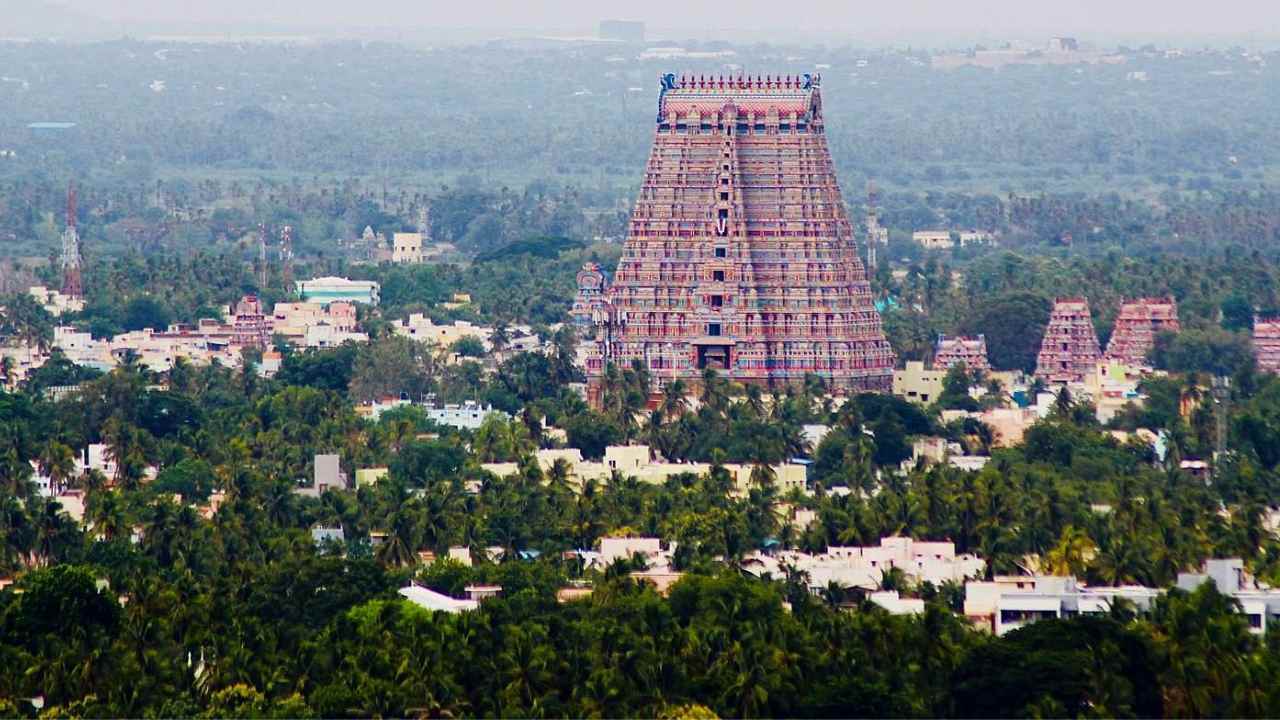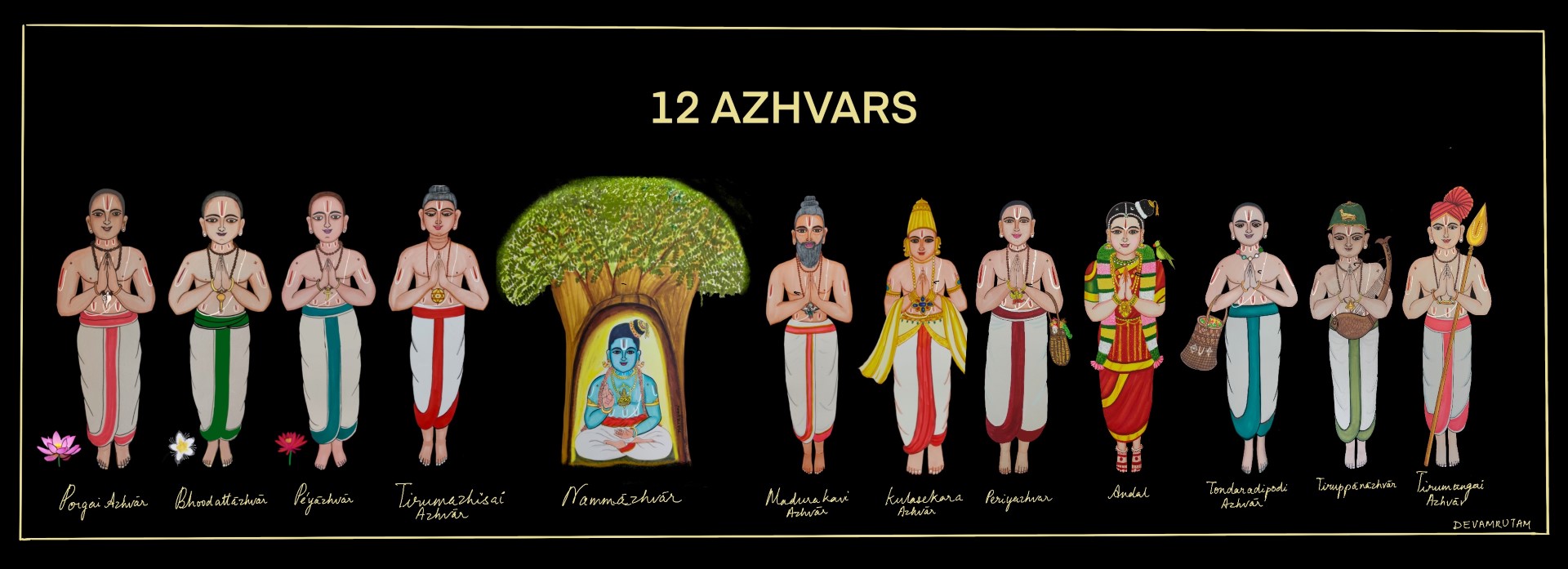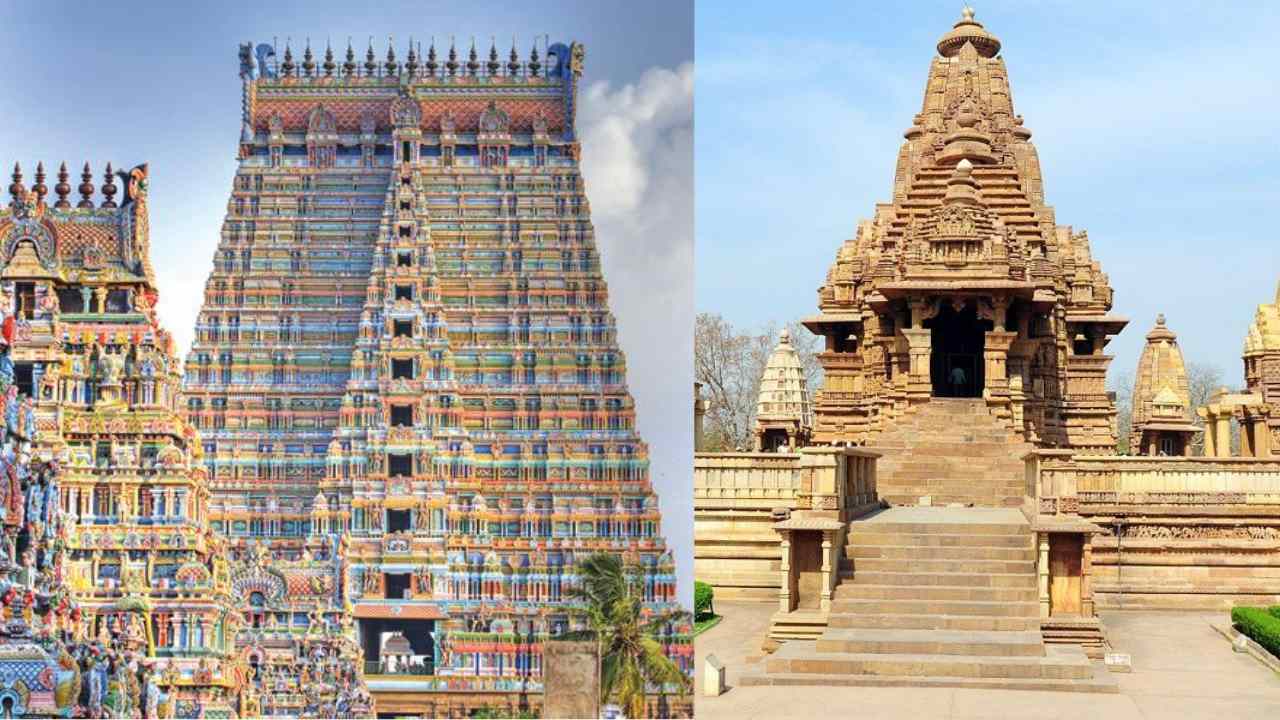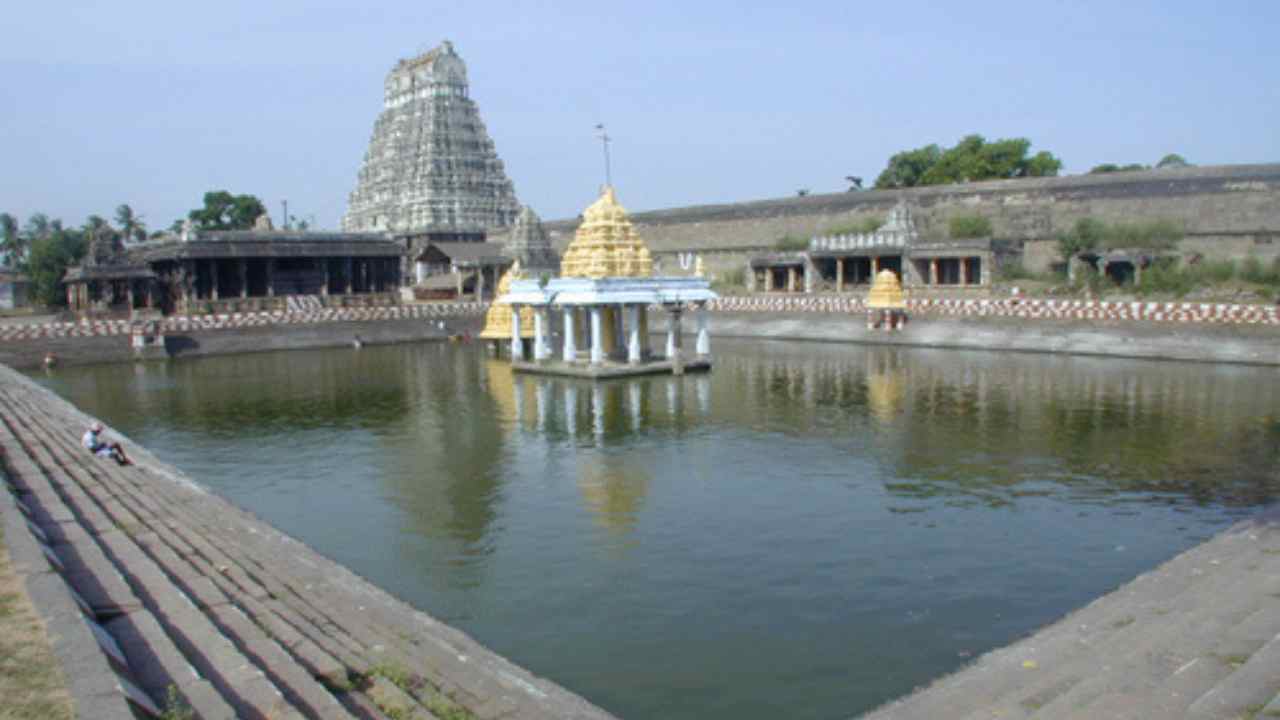108 Divya Desam

Introduction to the 108 Divya Desam
The 108 Divya Desam hold a special place in the Vaishnavism tradition, which marks the holy homes that belong to Lord Vishnu. They are revered for their spiritual significance as well as their relationship to the Alvars who were the saint-poets of 12 who have dedicated all their time to sing praises of Vishnu by singing their hymns which are collectively referred to as”Nalayira Divya Prabandham. “Nalayira Divya Prabandham.” The hymns are the foundation to Vaishnavite devotional literature and highlight the significance of these temples.
Origin and Historical Significance
The word “Divya Desam” signifies a sacred place where the god (Perumal) is sanctified through the Alvars songs. The story of these temples is interspersed with the devotional work of the Alvars who lived during the medieval period of Tamil Nadu. Their songs celebrated the splendor of Vishnu and offered spiritual direction to devotees, urging them to pursue moksha (liberation) by piety and sacrifice to the gods.
They Alvars have been believed to be the incarnations of Lord Vishnu who came to Earth to promote the path of Bhakti (devotion). The Alvars traveled widely, going to different temples and writing songs that highlighted the sacredness and distinctive aspects of these sacred places for worship. Their work, collectively referred to in the “Nalayira Divya Prabandham,” are a spiritual map for worshippers and guide them to these holy sites.
Distribution of the Divya Desams
Of the 108 Divya Desams, 106 are situated on Earth most of them located in Tamil Nadu, which hosts most of the temples. These temples are some of the historical places of Tamil Nadu. Other states like Kerala, Andhra Pradesh, and Uttar Pradesh also have several Divya Desams, with one situated in Nepal. The two remaining Divya Desams, Thirupalkadal and Paramapadam are believed to be in the celestial realm and represent the abode of God Vishnu at Vaikuntha.
Architectural and Cultural Significance
The Divya Desam temples are architectural marvels that showcase intricate carvings and impressive gopurams (temple towers) and magnificent vimanas (sanctum towers). These structures represent the rich culture of India and the fervor for devotion that has been maintained over time. The temples aren’t only sites of worship, but also cultural and artistic centers that host various ceremonies and festivals are celebrated with great enthusiasm.
Spiritual Practices and Rituals
A visit to the Divya Desam is believed to be to be a spiritually profound experience. People who are devoted to the religion participate in different rituals like Abhishekam (sacred bath), Archana (offerings to the god) and Pradakshina (circumambulation around the holy sanctum). These practices are believed by many to cleanse the soul and mind and bring the person closer to God.
Festivals and Celebrations
The Divya Desam temples come to life when festivals are celebrated with a lot of enthusiasm and fervor. Festivals of great importance like Vaikunta Ekadasi as well as Brahmotsavam are attended by thousands of worshippers. These celebrations include vibrant procession along with religious celebrations and lively cultural performances that highlight the collective devotion of the community.
Conclusion
The 108 Divya Desams are not just temples, but spiritual places that provide comfort and insight to those who seek them. They symbolize the long-lasting tradition of the Alvars as well as their devotional hymns, leading devotees to the path of bhakti, and toward the ultimate objective of moksha. The temples remain the centers of religion, culture and spirituality, which attract visitors from all over the world.
12 Alwars

Twelve Alvars are holy saints revered in the Vaishnavite tradition of Hinduism. Their hymns of devotion, called the Divya Prabandham is the foundational part of this Sri Vaishnavism sect. They believe to represent the incarnations of different types of Lord Vishnu and are sent to Earth to spread the practice of bhakti (devotion) via their poems and teachings. Below is a brief description about each Alvar:
1. Poigai Alvar is believed to be the incarnation of Vishnu’s conch, Poigai Alvar was born in Kanchipuram. The composer of the “Mudhal Thiruvandhadhi,” a series of devotional songs and is renowned for his philosophical insights as well as his deep dedication.
2. Bhoothath Alvar: A incarnation of Vishnu’s Mace His birthplace was Mahabalipuram. His works, such as his famous poem “Irandaam Thiruvandhadhi,” emphasize the power of divine love and the joy that comes in surrendering to God.
3. Pey Alvar depicting the sword of Vishnu, Pey Alvar was a native of Mylapore. His compositions, like “Moonram Thiruvandhadhi,” focus on the joy of having divine visions and the importance of loving God.
4. Thirumalisai Alvar was born at Thirumalisai the city of Thirumalisai, he is believed to be to be the embodiment the discus of Lord Vishnu. His most notable works include “Naanmugan Thiruvandhadhi,” which examines the nature of the divine and soul’s relationship to God.
5. Nammalvar Nammalvar of the most well-known alvars Nammalvar is a Tamil born Alwarthirunagari. His many contributions include “Thiruvaimozhi,” a cornerstone of Tamil devotional literature, which depicts the soul’s desire to be united with Vishnu.
6. Madhurakavi Alvar is a devotee of Nammalvar He was born in Thirukolur. He stands out among the Alvars in that he composed songs solely to praise Nammalvar, his guru. Nammalvar particularly within his hymn “Kanninun Siruthambu.”
7. Kulasekara Alvar: A King from Kerala, Kulasekara Alvar identified himself as a embodiment that of the Vishnu Kaustubha gem. Its “Perumal Thirumozhi” reflects his dedication to the royal family and his deep devotion in Rama as well as Krishna.
8. Periyalvar born in Srivilliputhur and is regarded as the personification of Garuda Vishnu’s vehicle. The epic poem “Periyalvar Thirumozhi” contains vivid stories of Krishna’s early years, showing his parents’ love for the god of God.
9. Andal The sole female Alvar and Periyalvar’s adopted daughter, her compositions include “Thiruppavai” and “Nachiyar Thirumozhi.” The hymns she composed are full of sentimental love and devotion to Krishna and portrays her in the role of his wedding.
10. Thondaradippodi Alvar born in Thirumandangudi and is a symbol of the garland of Vishnu. His works, like “Thirumaalai” are steeped in reverence and humility, highlighting the devotion to God.
11. Thiruppaan Alvar: A representation of Vishnu’s Srivatsa marking He was born in Uraiyur. Its “Amalan Adhipiran” is a stunning poetic representation of the divine nature and characteristics of Vishnu.
12. Thirumangai Alvar is a warrior, and embodiment of the bow of Vishnu, the man was from Thirukurayalur. His many contributions, like”Periya Thirumozhi,” are rich in devotion “Periya Thirumozhi,” are full of devotion and details the splendor of different Vishnu temples.
Vimana

The term “Vimana” is used in Hindu temple architecture the phrase “Vimana” refers to the structure that rises over the sanctum sanctorum, or the garbhagriha, which houses a principal god within the shrine. The structure is an important aspect of the symbolism and design associated with Hindu temples, specifically those built in their South Indian Dravidian architectural style as well as that of the North Indian Nagara style.
Significance and Symbolism
The Vimana isn’t just an architectural element, it also has significant symbolic meaning. It is frequently regarded as to be the visual representation of God’s presence, and is often equated with the face of God. The significance of this is evident in numerous texts, such as the Agamas which are the sacred texts that govern the construction of temples and the practice of rituals. In these scriptures, looking at the Vimana is similar to being in the presence of God which is a direct link to God.
Structural Components
The structure of the Vimana is complex, with many layers and components that convey a symbolic meaning. In its simplest design, the single-storeyed Ekatala Vimana is comprised of six major elements:
- Adhisthana (base or base)
- Pada (pillars)
- Prastara (entablature)
- Griva (neck)
- Shikhara (head or peak)
- Kalasha (finial also known as crown)
Multi-storeyed Vimanas similar to Dwitala (two stores) as well as Tritala (three levels) include an additional layer (talas) between the primary elements, further developing the significance of ascent toward the gods.
Regional Variations
The design and construction of Vimanas differ greatly in their Dravidian as well as Nagara style of architectural design. For instance, in the Dravidian style, which is the predominant style in the southern part of India Vimanas are constructed in the style of southern India. Vimana typically consists of constructed as a pyramidal structure that is embellished with intricate carvings and sculptures. Some examples include the imposing Vimanas from The Brihadeeswarar temple located in Thanjavur located at 216 feet, which makes it among the highest Vimanas within the region.
The Nagara style that is characteristic of northern India has a curvilinear, beehive-shaped and curly tower called the Shikhara. In the Lakshmana Temple in Khajuraho is an iconic example from Nagara style. Nagara style, in which the Vimana resembles mountains in a series that represent that mythical mountain Meru which is the axis of mundi of Hindu Cosmology.
Types and Styles
There are a variety of Vimanas that are described in the traditional texts, each one with distinct symbolism and architectural features. For example:
- Parvata Vimana Reminisces of an mountain.
- Kalyana Vimana: Symbolizes auspiciousness.
- Swastika Vimana: The symbol is a swastika.
These variations are usually customized to the particular god and local architectural tradition and create a variety in the temple design throughout India .
Conclusion
The Vimana is a keystone in Hindu temple architecture that embodies both artistic splendor and spiritual significance. It acts as an intermediary between the physical and the transcendent, leading worshippers to a higher state of consciousness by the elaborate design, as well as sacred geometrical. It is a towering structure, whether in the imposing structures of Dravidian temples or curvilinear mountains in the Nagara style The Vimana is a testimony to the architectural aplomb and the spiritual profundity the ancient Indian tradition.
Temple Tank

The temple tank is also referred to by the name of “kalyani” or “pushkarini” in South India, is a reservoir of water that is built on the grounds of Hindu temples. These tanks have important architectural, spiritual, and environmental significance in Hindu tradition.
Spiritual and Ritual Importance
Temple tanks play a significant function in the ritualistic and religious practice of Hinduism. They are typically utilized for different ceremonial functions as well as ritual purification prior to the worship service, which requires taking baths in the tank’s waters. The belief behind this practice is that it helps rid the worshippers of spiritual and physical impureties. In the course of festivals, particularly those that include the processions of the gods temple tanks are the location for important rituals. For instance, in certain customs, the idol of the god is immersed in the water, representing the sanctification of the environment and community.
Architectural Significance
Architecturally temple tanks are a key component to the temple’s complex, which reflects the old Indian designs, which are based on harmony with the natural world. The layout of a Hindu temple, known as “vastu-purusha-mandala,” often includes a temple tank as a vital element. The tanks are usually constructed with steps that lead to the water and allowing the devotees to walk right into them. The tanks are built with brick or stone and are typically decorated with intricate sculptures and carvings which enhance the temple’s visual attraction.
Ecological and Community Role
Beyond their architectural and religious functions, temple tanks serve vital ecological and social roles in the community. In the past the tanks were used to harvest rainwater which helps to replenish the levels of groundwater and providing an ongoing supply of water to the temple and the surrounding areas. This practice is a testament to the old Indian knowledge of water conservation and management. In addition, temple tanks frequently serve as a community hub where people congregate, which encourages interactions and bonds between the community.
Examples and Styles
Temple tanks are available in different sizes and styles across India which often reflect the architecture of the region. The region of South India, temple tanks are especially well-known, with examples like the tank at The Meenakshi Temple in Madurai, that is a sacred as well as an architectural wonder. The tank is enclosed by a corridor that is colonnaded and has exquisitely built altars and pillars. The tank located at the Brihadeeswarar Temple in Thanjavur which is one of UNESCO World Heritage Sites, is a perfect example of the beauty in spiritual importance of the bodies of water.
In the end temple tanks are more than reservoirs of water; they are sacred spaces that enrich the architectural, spiritual, and ecological facets in Hindu temples. They are a symbol of architecture, nature, and spirituality, which reflects the whole-of-life vision of the ancient Indian civilization.
Key Aspects to Know Before Visiting a Divya Desam
1. Perumal’s Name
In each Divya Desam, Lord Vishnu manifests in a unique form, referred to as Perumal. The name of Perumal in each temple often reflects a specific attribute or legend associated with that incarnation. For instance, in Srirangam, He is known as Ranganathar, reclining majestically, signifying cosmic rest and eternal peace.
2. Thayar’s Name
Accompanying Perumal in each temple is His consort, Thayar, a manifestation of Goddess Lakshmi. Thayar’s presence symbolizes compassion, grace, and the nurturing aspect of divinity. Her name often complements that of Perumal, highlighting their inseparable bond and joint role in bestowing blessings upon devotees.
3. Temple’s Old Name
Many of these temples have ancient names rooted in historical, mythological, or geographical contexts. These names often provide insights into the temple’s origin, significance, and the legends surrounding it. For example, Srirangam is also known as Bhoologa Vaikundam, meaning the Vaikuntha (heavenly abode) on Earth.
4. Vimanam’s Name
The Vimanam is the sanctum’s tower, a distinctive architectural feature in each temple. Each Vimanam has a specific name and design that holds spiritual symbolism and reflects the temple’s divine narrative. For example, the Pranavakara Vimanam in Srirangam symbolizes the sacred syllable ‘Om’, representing the essence of the universe.
5. Name of the Temple Tank
Temple tanks, or Pushkarinis, are integral to the sacred landscape of Divya Desams. These water bodies are considered holy, with beliefs in their purifying and healing properties. Devotees often perform ritual baths in these tanks as an act of purification and devotion. For instance, the Chandra Pushkarini in Srirangam is revered for its sanctity.
6. Which Azhwar Has Praised the Temple
The Divya Prabandham, composed by the Azhwars, is a collection of hymns that praise the glory of Lord Vishnu and these sacred temples. Each Divya Desam has been extolled by one or more Azhwars, whose verses capture the spiritual essence and divine presence felt within these temples. Knowing which Azhwar has sung about a particular temple adds a layer of devotional depth and historical context to the visit.
108 Divya Desam List
108 Divya Desam Temples based on their locations in different states and regions:
Nepal (1), North India (8), Tamil Nadu (84), Kerala (11) and Andhra Pradesh (2) Vinnulagam (2)
Andhra Pradesh
- Tirumala Venkateswara Temple
- Ahobilam
Nepal
- Muktinath, Saligramam
Uttar Pradesh
- Naimisaranya
- Mathura
- Gokul
- Ayodhya
Uttarakhand
- Raghunathji Temple
- Badrinath Temple
- Jyotirmath (Joshimutt)
Gujarat
- Dwarka
Malai Nadu (Kerala)
- Sri Padmanabhaswamy Temple
- Thirukatkarai
- Moozhikkalam
- Tiruvalla
- Thirukadithanam
- Sengunroor
- Thiruppuliyoor
- Thiruvaaranvilai
- Thiruvanvandoor
- Thiru Naavaay
- Viththuvakkodu
Tamil Nadu
Madurai
- Thirumeyyam
- Thirukoshtiyur
- Koodal Azhagar Temple
- Azhagar Kovil
- Tirumogoor
- Srivilliputhur
- Tiruththangal
- Thiruppullani
Chennai
- Thiruvallikeni
- Thiruneermalai
- Thiruvidandai
- Thirukadalmallai
- Thiruninravur
- Thiruvallur
- Thirukkadigai
Thanjavur
- Thiruccithra kootam
- Thirukkannangudi
- Thirunagai
- Thiru Thanjai
- Thirukkoodaloor
- Thiru Kavith Thalam
- Thiru Adhanoor
- Thirupullabhoothangudi
- Thirukkudandhai
- Thiruccherai
- Thirunandipura Vinnagaram
- Thiru Naraiyoor
- Thiruvinnagar
- Thiruvelliyangudi
- Thirukkanamangai
- Thirukkkannapuram
- Thiruvahithipuram
- Tirukkoilur
- Thirukkandiyur
Mayiladuthurai and Sirkazhi
- Thiruvazhunthoor
- Thiruindaloor
- Kazheesirama Vinnagaram
- Thirukkavalampadi
- Thiruchsemponsey
- Thiruarimeya Vinnagaram
- Thiru Vanpurushothamam
- Thiruvaikunda vinnagaram
- Thirumanimadam
- Thiruthevanartthogai
- Thiruthetriyambalam
- Thirumanikkoodam
- Thiruvellakkulam
- Thiruppaarththanpalli
- Thalai Sanga Nanmathiyam
- Thiruchsirupuliyur
- Thiruvali-Thirunagari
Kanchipuram
- Tirukkacchi
- Ashtabujakaram
- Tiruvekkaa
- Tiruththanka
- Tiruvelukkai
- Tirukalvanoor
- Tiru oorakam
- Tiru neeragam
- Tiru kaaragam
- Tirukaarvaanam
- Tiru parameswara vinnagaram
- Tiru pavala vannam
- Tiru paadagam
- Nilathingal Thundam Perumal Temple
- Thiruputkuzhi
Tirunelveli
- Thiruvaramangai
- Thirukkurungudi
- Srivaikundam
- Thiruvaragunamangai
- Thiruppulingudi
- Thirukkurugoor
- Thirutthulaivillimangalam
- Thirukkoloor
- Thirukkulandhai
- Thentirupperai
Trichy
- Sri Rangam
- Thirukkozhi
- Thirukkarambanoor
- Thiruvellarai
- Thiru Anbil
- Thirupper Nagar
Kanyakumari
- Thiruvattaru
- Thiruvanparisaram
Vinnulagam (Outside the Earthly realm)
- Thirupalkkadal
- Paramapadam
Conclusion
The 108 Divya Desams are not just an assortment of temples, they are the spiritual center of Vaishnavism which serves as a powerful places of worship as well as culture and heritage. Each of these sacred places for Lord Vishnu is recited in the Alvars’ hymns poets, who are a testament to the spiritual power and the spiritual value of these sacred temples. These Divya Desams are located across various regions of the world and each one is unique in its architectural beauty, historical richness as well as a distinctive representation that is divine.
The spiritual journey that is The Divya Desams can be described as a voyage through the essence of Bhakti (devotion). It’s an exploration of the diverse forms and attributes of Vishnu as well as the stories and myths which highlight the god’s goodness and splendor. From the imposing gopurams of The Srirangam Temple to the serene shores of the Azhagar Kovil, every temple offers a unique chance for devotees to commune to the gods to seek out blessings and feel peace within.
The 108 Divya Desams also reflect the rich artistic and cultural tradition of India. These temples are architectural marvels which showcase the beauty of Dravidian and Nagara styles, decorated in intricate carvings grand vimanas as well as holy temple tankers. They’re living testimony to the wisdom of the past and religious fervor that has been preserved throughout the ages.
Going to these temples is not just a simple pilgrimage, but it is a transformational experience that purifies the spirit, lifts the spirit, and draws people closer to the ultimate aim that is moksha (liberation). The tradition of the Alvars and their hymns of devotion continue to inspire thousands of people who are guided by the path of dedication serving, charity as well as spiritual awakening.
The of the 108 Divya Desams are sacred treasures which provide comfort, insight and a profound spiritual connection and make these a vital part of the Indian cultural and spiritual landscape.

Pingback: Explore 108 divya desam in kerala: A spiritual journey
Pingback: 108 divya desam in north india, nepal and UP
Pingback: 108 divya desam in tamil nadu
Pingback: divya desams in Thanjavur & Kumbakonam - My Budget Travel
Pingback: divya desams in mayiladuturai